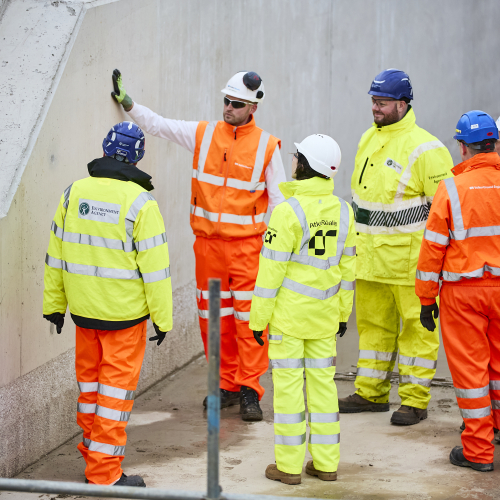
Exploring ultra-low carbon mixes on the Littleborough Flood Risk Management Scheme
Phase 1B of the Rochdale and Littleborough Flood Risk Management Scheme (FRMS) includes the construction of a flood storage reservoir, new linear defences both upstream and downstream, and modifications to existing flood defences along the River Roch, Greenvale Brook, and Ealees Brook.

Once complete, the scheme will protect 723 homes and 488 businesses in Littleborough and Rochdale, Greater Manchester, from flood risk.
Concrete and carbon: The challenge
The project involves approximately 1,900m³ of structural concrete, including a major flow control structure measuring 70m long and 7m high. As part of the Environment Agency’s Decarbonisation Technology Accelerator (DTA) initiative, VolkerStevin was tasked with going beyond standard low-carbon specifications to identify the lowest embodied carbon concrete mix that still met all performance and durability requirements.
Why it matters
Concrete production is a major contributor to global carbon emissions, largely due to the high clinker content in traditional cement. For the Environment Agency, concrete accounts for around 25% of its total carbon footprint. To address this, the Agency has adopted ambitious targets, including the use of concrete with a Market Benchmark Rating of B / LCCG2 or better, as outlined in its Minimum Technical Requirements and NEC4 Engineering and Construction Contracts.
Innovating for impact
While the original concrete specification already included high levels of Ground Granulated Blast Furnace Slag (GGBS) as a clinker replacement, the team pushed further. Working within BS 8500 standards, they transitioned from CIIIA and CIIIB concretes to a CIIA-L cement blend. This involved replacing 15% of the CEMI clinker with limestone fines before blending with GGBS—creating a ternary cement mix.
This approach aligns with the November 2023 update to BS8500, which supports the use of multiple cement substitutes in a single binder, as well as with the Environment Agency’s goal of using lower carbon concretes with a wider range of cement replacements. The result: a significant reduction in embodied carbon without compromising structural performance.
The results
- C40/50 concrete mix: 7.8 tonnes CO2e saved
- Other mixes: 4.5 tonnes CO2e saved
- Cost impact: A modest increase of £3/m³, expected to decrease as demand and supply for ternary mixes grow.
Importantly, crushed limestone, used as a clinker substitute, avoids the high-energy kiln process, making it a more sustainable and cost-effective material in the long term.